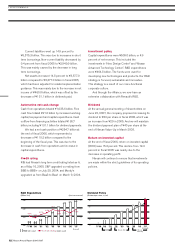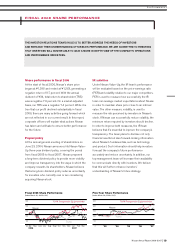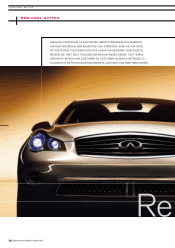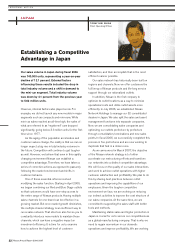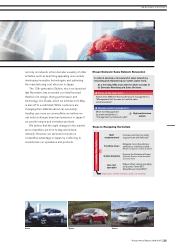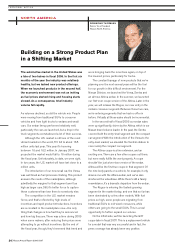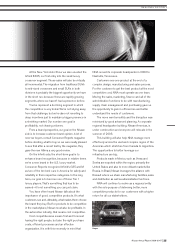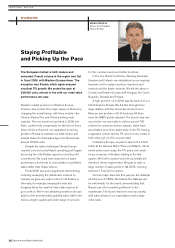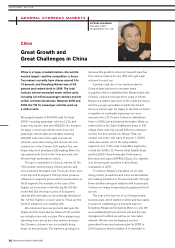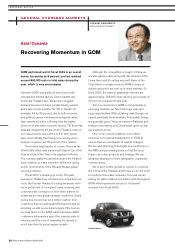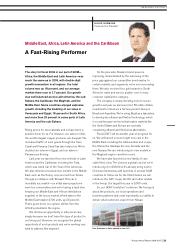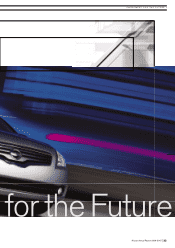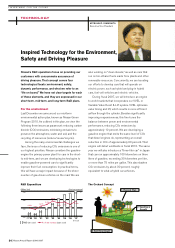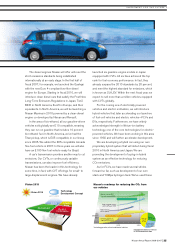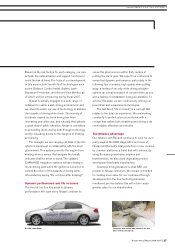Nissan 2007 Annual Report Download - page 30
Download and view the complete annual report
Please find page 30 of the 2007 Nissan annual report below. You can navigate through the pages in the report by either clicking on the pages listed below, or by using the keyword search tool below to find specific information within the annual report.
China is a huge, crowded market—the world’s
second largest—and the competition is fierce.
Ten makers currently have shares around 5 to
10 percent, and Dongfeng Nissan was at 4.8
percent and ranked ninth in 2006. The total
industry volume exceeded seven million units,
including 4.2 million passenger vehicles and 2.8
million commercial vehicles. Between 2005 and
2006, the TIV for passenger vehicles went up
a million units.
We projected sales of 484,000 units for fiscal
2006—including passenger vehicles, LCVs, and
heavy-duty trucks—and sold 482,500. Our numbers
for larger commercial vehicles were down, but
passenger vehicle sales accelerated, reaching
200,000 units. Our LCVs—light commercial
vehicles—were also moving well, and we are now
number two in the Chinese LCV market. Our new
heavy-duty truck developed at Dongfeng Motor Co.
was named both Truck of the Year and most fuel-
efficient high-performance vehicle.
The price competition in China is intense. Of the
156 models currently being offered, just ten sold
over a hundred thousand units. Prices are down even
in the top-end D segment. This top-down pressure
influences C segment prices, which presses down on
the B segment. For example, in the case of the
Sylphy, our focus was on introducing the 2.0-liter
model first. But the drop in price of D segment
vehicles affected sales, so we’ve already introduced
the 1.6-liter Sylphy to recover volume. Those are the
kinds of situations we’re dealing with.
We introduced two new products last year, the
Sylphy and the Livina Geniss. Sales of both models
are virtually in line with our plan. We’re always busy
launching new cars, as are other makers, because
the Chinese customer’s eye is constantly being
drawn to new products. The market is growing, but
because this growth is driven by frequent launches
from various makers it’s very difficult to get major
volumes for each car.
A primary objective of our business plan for
China to date has been to increase brand
recognition. We’ve established the Nissan brand with
Chinese customers through three years of efforts.
Nissan is a relative latecomer to the market, however,
and the younger generation in particular doesn’t
know us well enough. I’m happy to say that our brand
recognition is continually improving—we were
second in the J. D. Powers Customer Satisfaction
Index in 2006, just a bit behind the leader. While we
ranked sixth in the Sales Satisfaction Index or SSI
ratings, there was only a small difference between
number two and number six. Nissan Tiida, our
number one seller, with sales of around 110,000
units, was number one in the entry midsize
segment—one of the most competitive segments—
in both the 2006 J. D. Powers Initial Quality Study
and the 2006 China Automotive Performance,
Execution and Layout (APEAL) Study. Our objective
is to be among the top three in all of these
evaluations in 2007.
To enhance Nissan’s reputation we are also
doing product promotions and some social activities
and making donations to the less fortunate. Through
these activities and good relations with local people,
I believe our image is improving at a grassroots level
as well.
This year is the last one of our first-generation
business plan, which started in 2004 and has mainly
focused on establishing our business base for
Dongfeng Nissan and Dongfeng Motor Co. Ltd. We
were establishing the production site and the new
management method, as well as our new sales
network. We are now developing a second-
generation three-year business plan for 2008 to
2010 based on that foundation. It is essential for
Nissan Annual Report 2006-2007
28
Great Growth and
Great Challenges in China
China
KATSUMI NAKAMURA
President & CEO,
Dongfeng Motor Co., Ltd.
GENERAL OVERSEAS MARKETS
»REGIONAL ACTION


